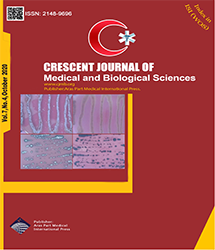| Original Article | |
| Psychometric Properties of the Iranian Version of a Perinatal Anxiety Screening Scale in Iranian Perinatal Population: A Methodological Study | |
| Shahla Barzgar-Molan1, Azizeh Farshbaf-Khalili2, Mohammad Asghari Jafarabadi3, Jalil Babapour4, Parisa Yavarikia5 | |
| 1Student Research Committee, Department of Midwifery, Faculty of Nursing and Midwifery, Tabriz University of Medical Sciences, Tabriz, Iran 2Aging Research Institute, Physical Medicine and Rehabilitation Research Centre, Tabriz University of Medical Sciences, Tabriz, Iran 3Department of Statistics and Epidemiology, Faculty of Health, Tabriz University of Medical Sciences, Tabriz, Iran 4Faculty of Education and Psychology, Tabriz University, Tabriz, Iran 5Department of Midwifery, Faculty of Nursing and Midwifery, Tabriz University of Medical Sciences, Tabriz, Iran |
|
|
CJMB 2020; 7: 551-559 Viewed : 5309 times Downloaded : 3368 times. Keywords : Validity, Reliability, Perinatal Anxiety Screening Scale |
|
| Full Text(PDF) | Related Articles | |
| Abstract | |
Objectives: The purpose of this study was to evaluate the validity of a Persian-language perinatal anxiety screening tool in the Iranian population. Materials and Methods: This cross-sectional study was performed on 300 low-risk women who participated in the perinatal period. Pregnant women aged 18-42 years were randomly selected from comprehensive health centers in Ardabil, Iran and included in the study from 9.10.2017 to 6.3.2018, and finally, followed up as well. Several questionnaires were used in this study, including demographic, perinatal anxiety, perceived stress, and postpartum depression in Edinburgh. The forward-backward method was used to translate the English version of the tool into Persian. Eventually, the content and face validity were assessed and the reliability of the tool was evaluated using the intra-class correlation coefficient (ICC) and Cronbach"s alpha coefficient. Results: The validation of the anxiety instrument showed that the content validity ratio (CVR) (0.6-0.1) and content validity index (CVI) (0.8-1.0) were acceptable. Using the exploratory factor analysis (EFA) (χ2 = 4.966, df = 465, and P < 0.01), reliability assessment demonstrated that the instrument had four subscales. The mean (standard deviation) of the total score of the instrument in pregnancy and delivery was 36.6 (13.1) and 43.3 (7.7) in the range of 0-93, respectively. Finally, the Cronbach"s alpha coefficient (0.84-0.94) and ICC of 0.96 (95% CI: 0.93-0.98) revealed that the instrument has a high ICC and excellent test-retest. Conclusions: In general, the findings of this study support the validity and reliability of the tool thus it can be used in clinical and research cases. |
Cite By, Google Scholar
Google Scholar
PubMed
Online Submission System
 CJMB ENDNOTE ® Style
CJMB ENDNOTE ® Style
 Tutorials
Tutorials
 Publication Charge
Medical and Biological Research Center
About Journal
Publication Charge
Medical and Biological Research Center
About Journal
Aras Part Medical International Press Editor-in-Chief
Arash Khaki
Deputy Editor
Zafer Akan


















